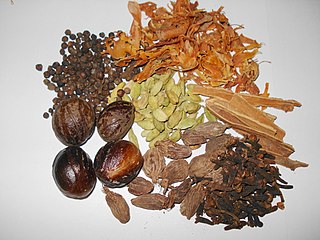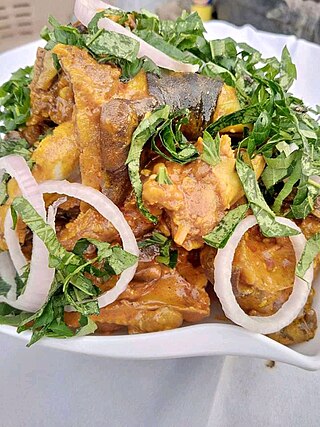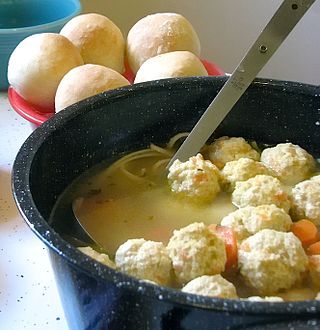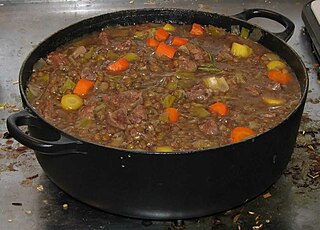
Tripe is a type of edible lining from the stomachs of various farm animals. Most tripe is from cattle, pigs and sheep.

Spice mixes are blended spices or herbs. When a certain combination of herbs or spices is called for in a recipe, it is convenient to blend these ingredients beforehand. Blends such as chili powder, curry powder, herbes de Provence, garlic salt, and other seasoned salts are traditionally sold pre-made by grocers, and sometimes baking blends such as pumpkin pie spice are also available. These spice mixes are also easily made by the home cook for later use.

Biryani is a mixed rice dish, mainly popular in South Asia. It is made with rice, some type of meat and spices. To cater to vegetarians, in some cases, it is prepared by substituting vegetables or paneer for the meat. Sometimes eggs and/or potatoes are also added.

Ghanaian cuisine refers to the meals of the Ghanaian people. The main dishes of Ghana are centered around starchy staple foods, accompanied by either sauce or soup as well as a source of protein. The primary ingredients for the vast majority of soups and stews are tomatoes, hot peppers, and onions. As a result of these main ingredients, most Ghanaian soups and stews appear red or orange.

West African cuisine encompasses a diverse range of foods that are split between its 16 countries. In West Africa, many families grow and raise their own food, and within each there is a division of labor. Indigenous foods consist of a number of plant species and animals, and are important to those whose lifestyle depends on farming and hunting.

Nigerian cuisine consists of dishes or food items from the hundreds of Native African ethnic groups that comprises Nigeria. Like other West African cuisines, it uses spices and herbs with palm oil or groundnut oil to create deeply flavored sauces and soups.

Tunisian cuisine, the cuisine of Tunisia, consists of the cooking traditions, ingredients, recipes and techniques developed in Tunisia since antiquity. It is mainly a blend of Mediterranean and native Punics-Berber cuisine. Historically, Tunisian cuisine witnessed influence and exchanges with many cultures and nations like Italians, Andalusians, French and Arabs.

Isi ewu is a traditional Igbo dish that is made with a goat's head.

The cuisine of Equatorial Guinea is a blend of the cuisines of the native peoples of this African country, including the Annobonese, the Bubi, the Fang, and the Kombe. It is also influenced by the cuisines of Spain ; other African nations such as Nigeria and Cameroon; Islamic states such as Morocco; and Creole cuisine overall. Its cuisine incorporates various meats, including game and bushmeat as well as imports, and is known for its strong flavors and high spice levels. Fish and chicken are common dishes.

Serundeng refers to a spicy grated coconut side dish or condiment originated in Indonesia that is used to accompany rice. Serundeng may taste sweet or hot and spicy, according to the recipe variants.

A meatball is ground meat (mince) rolled into a ball, sometimes along with other ingredients, such as bread crumbs, minced onion, eggs, butter, and seasoning. Meatballs are cooked by frying, baking, steaming, or braising in sauce. There are many types of meatballs using different types of meats and spices. The term is sometimes extended to meatless versions based on legumes, vegetables or fish; the latter are also commonly known as fish balls.

Nasi kebuli is an Indonesian variation of pilaf. It consists of rice cooked in goat meat broth, goat milk, and clarified butter. It is popular among the Arab community in Indonesia and Betawi people in Jakarta. Nasi kebuli was influenced by Arab culture and its origin can be traced to Middle eastern cuisine, especially Yemeni Arabian influence, Indian cuisine influence, and Afghan influence.

Peppersoup is a soup from Nigeria, made using various meats or fishes, chili peppers, scent leaves and calabash nutmeg as the primary ingredients. It is a spicy soup that has a light, watery texture. Despite its name, the soup is not necessarily defined by a pepper-forward flavor profile, that is, the flavors are much more complex, with nutty, bitter, woodsy, and floral notes, as well as warmth. It is considered to be a delicacy by some people in Western Africa, and some West Africans believe that the soup has some basic medicinal qualities.

A stew is a combination of solid food ingredients that have been cooked in liquid and served in the resultant gravy. Ingredients can include any combination of vegetables and may include meat, especially tougher meats suitable for slow-cooking, such as beef, pork, venison, rabbit, lamb, poultry, sausages, and seafood. While water can be used as the stew-cooking liquid, stock is also common. A small amount of red wine or other alcohol is sometimes added for flavour. Seasonings and flavourings may also be added. Stews are typically cooked at a relatively low temperature, allowing flavours to mingle.

Mala xiang guo, roughly translated into English as "spicy stir-fry hot pot", is a Chinese dish prepared by stir frying. Strongly flavored with mala, it often contains meat and vegetables, and has a salty and spicy taste. The preparation process involves placing the required ingredients in the pot, stir frying and adding seasoning. In restaurants, customers usually choose the ingredients by themselves before the chef prepares the dish.

Nkwobi is a delicacy commonly found in restaurants, it is otherwise known as nkwobi. The cuisine is common among the people of Igbo ethnic group. it is a soup made up of cuts from cow feet.

Asaro, also known as yam porridge or yam pottage, is a traditional dish originating from the Yoruba of Nigeria, Benin Republic and Togo. It is a one-pot meal made from yam, a starchy tuber, and a variety of other ingredients. It can be enjoyed as a main course or a side dish.

















